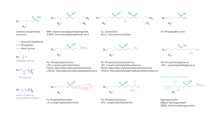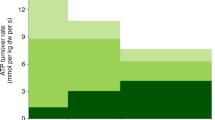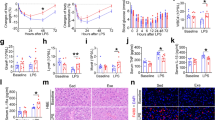Abstract
Increased wave reflection (augmented pressure (AP) and augmentation index (AIx)) and reduced muscle strength may increase cardiovascular risk in postmenopausal women. We evaluated the effects of whole-body vibration exercise training (WBVET) on aortic haemodynamics and leg muscle strength. Twenty-eight postmenopausal women (age, 56±3 years; brachial systolic blood pressure (SBP) 138±12 mm Hg; body mass index, 33.9±3.7 kg m−2) were randomized to 6 weeks of WBVET (n=15) or no-exercise control groups. Aortic SBP, diastolic blood pressure (DBP), pulse pressure (PP), AP, AIx, tension time index (TTI, myocardial oxygen demand) and leg press muscle strength were measured before and after 6 weeks. WBVET significantly (P<0.05) decreased aortic SBP (∼10 mm Hg), DBP (∼5 mm Hg), PP (∼5 mm Hg), AP (∼5 mm Hg), AIx (∼10%) and TTI (∼311 mm Hg s per minute), while increased muscle strength (∼9%) compared with no changes after control. Changes in AP and leg muscle strength were correlated (r=−0.58, P=0.02). Our data demonstrated that WBVET reduced pressure wave reflection magnitude and aortic blood pressure in postmenopausal women with prehypertension or hypertension. Our study suggests that WBVET may decrease cardiovascular risk in postmenopausal women by improving wave reflection and muscle strength.
This is a preview of subscription content, access via your institution
Access options
Subscribe to this journal
Receive 12 digital issues and online access to articles
$119.00 per year
only $9.92 per issue
Buy this article
- Purchase on Springer Link
- Instant access to full article PDF
Prices may be subject to local taxes which are calculated during checkout



Similar content being viewed by others
References
Wykretowicz A, Adamska K, Guzik P, Krauze T, Wysocki H . Indices of vascular stiffness and wave reflection in relation to body mass index or body fat in healthy subjects. Clin Exp Pharmacol Physiol 2007; 34 (10): 1005–1009.
Namasivayam M, Adji A, O'Rourke MF . Influence of aortic pressure wave components determined noninvasively on myocardial oxygen demand in men and women. Hypertension 2011; 57 (2): 193–200.
Namasivayam M, McDonnell BJ, McEniery CM, O'Rourke MF . Does wave reflection dominate age-related change in aortic blood pressure across the human life span? Hypertension 2009; 53 (6): 979–985.
Russo C, Jin Z, Palmieri V, Homma S, Rundek T, Elkind MS et al. Arterial stiffness and wave reflection: sex differences and relationship with left ventricular diastolic function. Hypertension 2012; 62 (2): 362–368.
Delmonico MJ, Harris TB, Visser M, Park SW, Conroy MB, Velasquez-Mieyer P et al. Longitudinal study of muscle strength, quality, and adipose tissue infiltration. Am J Clin Nutr 2009; 90 (6): 1579–1585.
Newman AB, Kupelian V, Visser M, Simonsick EM, Goodpaster BH, Kritchevsky SB et al. Strength, but not muscle mass, is associated with mortality in the health, aging and body composition study cohort. J Gerontol A Biol Sci Med Sci 2006; 61 (1): 72–77.
Artero EG, Lee DC, Ruiz JR, Sui X, Ortega FB, Church TS et al. A prospective study of muscular strength and all-cause mortality in men with hypertension. J Am Coll Cardiol 2011; 57 (18): 1831–1837.
Heffernan KS, Chale A, Hau C, Cloutier GJ, Phillips EM, Warner P et al. Systemic vascular function is associated with muscular power in older adults. J Aging Res 2012; 2012: 386387.
Cecelja M, Jiang B, Spector TD, Chowienczyk P . Progression of central pulse pressure over 1 decade of aging and its reversal by nitroglycerin a twin study. J Am Coll Cardiol 2012; 59 (5): 475–483.
Figueroa A, Going SB, Milliken LA, Blew RM, Sharp S, Teixeira PJ et al. Effects of exercise training and hormone replacement therapy on lean and fat mass in postmenopausal women. J Gerontol A Biol Sci Med Sci 2003; 58 (3): 266–270.
Kingsley JD, Figueroa A . Effects of resistance exercise training on resting and post-exercise forearm blood flow and wave reflection in overweight and obese women. J Hum Hypertens 2012; 26 (11): 684–690.
Casey DP, Pierce GL, Howe KS, Mering MC, Braith RW . Effect of resistance training on arterial wave reflection and brachial artery reactivity in normotensive postmenopausal women. Eur J Appl Physiol 2007; 100: 403–408.
Cortez-Cooper MY, DeVan AE, Anton MM, Farrar RP, Beckwith KA, Todd JS et al. Effects of high intensity resistance training on arterial stiffness and wave reflection in women. Am J Hypertens 2005; 18 (7): 930–934.
Taaffe DR, Galvao DA, Sharman JE, Coombes JS . Reduced central blood pressure in older adults following progressive resistance training. J Hum Hypertens 2007; 21 (1): 96–98.
Kingsley JD, McMillan V, Figueroa A . Resistance exercise training does not affect postexercise hypotension and wave reflection in women with fibromyalgia. Appl Physiol Nutr Metab 2011; 36 (2): 254–263.
Figueroa A, Gil R, Wong A, Hooshmand S, Park SY, Vicil F et al. Whole-body vibration training reduces arterial stiffness, blood pressure and sympathovagal balance in young overweight/obese women. Hypertens Res 2012; 35 (6): 667–672.
Delecluse C, Roelants M, Verschueren S . Strength increase after whole-body vibration compared with resistance training. Med Sci Sports Exerc 2003; 35 (6): 1033–1041.
Machado A, Garcia-Lopez D, Gonzalez-Gallego J, Garatachea N . Whole-body vibration training increases muscle strength and mass in older women: a randomized-controlled trial. Scand J Med Sci Sports 2010; 20 (2): 200–207.
Verschueren SM, Roelants M, Delecluse C, Swinnen S, Vanderschueren D, Boonen S . Effect of 6-month whole body vibration training on hip density, muscle strength, and postural control in postmenopausal women: a randomized controlled pilot study. J Bone Miner Res 2004; 19 (3): 352–359.
Figueroa A, Vicil F, Sanchez-Gonzalez M . Acute exercise with whole-body vibration decreases wave reflection and leg arterial stiffness. Am J Cardiovasc Dis 2011; 1 (1): 60–67.
Lythgo N, Eser P, de Groot P, Galea M . Whole-body vibration dosage alters leg blood flow. Clin Physiol Funct Imaging 2009; 29 (1): 53–59.
Mahmud A, Feely J . Beta-blockers reduce aortic stiffness in hypertension but nebivolol, not atenolol, reduces wave reflection. Am J Hypertens 2008; 21 (6): 663–667.
Hashimoto J, Westerhof BE, Westerhof N, Imai Y, O'Rourke MF . Different role of wave reflection magnitude and timing on left ventricular mass reduction during antihypertensive treatment. J Hypertens 2008; 26 (5): 1017–1024.
Sherman S . Defining the menopausal transition. Am J Med 2005; 118 (12B): 3–7.
Perk J, De Backer G, Gohlke H, Graham I, Reiner Z, Verschuren WM et al. European Guidelines on cardiovascular disease prevention in clinical practice (version 2012): The Fifth Joint Task Force of the European Society of Cardiology and Other Societies on Cardiovascular Disease Prevention in Clinical Practice (constituted by representatives of nine societies and by invited experts). Atherosclerosis 2012 223 (1): 1–68.
Chemla D, Nitenberg A, Teboul JL, Richard C, Monnet X, le Clesiau H et al. Subendocardial viability ratio estimated by arterial tonometry: a critical evaluation in elderly hypertensive patients with increased aortic stiffness. Clin Exp Pharmacol Physiol 2008; 35 (8): 909–915.
Phillips MD, Flynn MG, McFarlin BK, Stewart LK, Timmerman KL . Resistance training at eight-repetition maximum reduces the inflammatory milieu in elderly women. Med Sci Sports Exerc 2010; 42 (2): 314–325.
Sakurai M, Yamakado T, Kurachi H, Kato T, Kuroda K, Ishisu R et al. The relationship between aortic augmentation index and pulse wave velocity: an invasive study. J Hypertens 2007; 25 (2): 391–397.
McEniery CM, Yasmin, Hall IR, Qasem A, Wilkinson IB, Cockcroft JR . Normal vascular aging: differential effects on wave reflection and aortic pulse wave velocity: the Anglo-Cardiff Collaborative Trial (ACCT). J Am Coll Cardiol 2005; 46 (9): 1753–1760.
Weber T, Auer J, O'Rourke MF, Kvas E, Lassnig E, Berent R et al. Arterial stiffness, wave reflections, and the risk of coronary artery disease. Circulation 2004; 109 (2): 184–189.
Vlachopoulos C, Aznaouridis K, O'Rourke MF, Safar ME, Baou K, Stefanadis C . Prediction of cardiovascular events and all-cause mortality with central haemodynamics: a systematic review and meta-analysis. Eur Heart J 2010; 31 (15): 1865–1871.
Prince CT, Secrest AM, Mackey RH, Arena VC, Kingsley LA, Orchard TJ . Pulse wave analysis and prevalent cardiovascular disease in type 1 diabetes. Atherosclerosis 2010; 213 (2): 469–474.
Silventoinen K, Magnusson PK, Tynelius P, Batty GD, Rasmussen F . Association of body size and muscle strength with incidence of coronary heart disease and cerebrovascular diseases: a population-based cohort study of one million Swedish men. Int J Epidemiol 2009; 38 (1): 110–118.
Heffernan KS, Yoon ES, Sharman JE, Davies JE, Shih YT, Chen CH et al. Resistance exercise training reduces arterial reservoir pressure in older adults with prehypertension and hypertension. Hypertens Res 2013; 36 (5): 422–427.
Acknowledgements
We thank Power Plate International for providing the vibration platforms. We also are grateful to the participants.
Author information
Authors and Affiliations
Corresponding author
Ethics declarations
Competing interests
The authors declare no conflict of interest.
Rights and permissions
About this article
Cite this article
Figueroa, A., Kalfon, R., Madzima, T. et al. Effects of whole-body vibration exercise training on aortic wave reflection and muscle strength in postmenopausal women with prehypertension and hypertension. J Hum Hypertens 28, 118–122 (2014). https://doi.org/10.1038/jhh.2013.59
Received:
Revised:
Accepted:
Published:
Issue Date:
DOI: https://doi.org/10.1038/jhh.2013.59
Keywords
This article is cited by
-
Impact of low-intensity resistance and whole-body vibration training on aortic hemodynamics and vascular function in postmenopausal women
Hypertension Research (2019)
-
Benefits of whole-body vibration training on arterial function and muscle strength in young overweight/obese women
Hypertension Research (2017)
-
Physical fitness, activity and hand-grip strength are not associated with arterial stiffness in older individuals
The Journal of nutrition, health and aging (2015)



